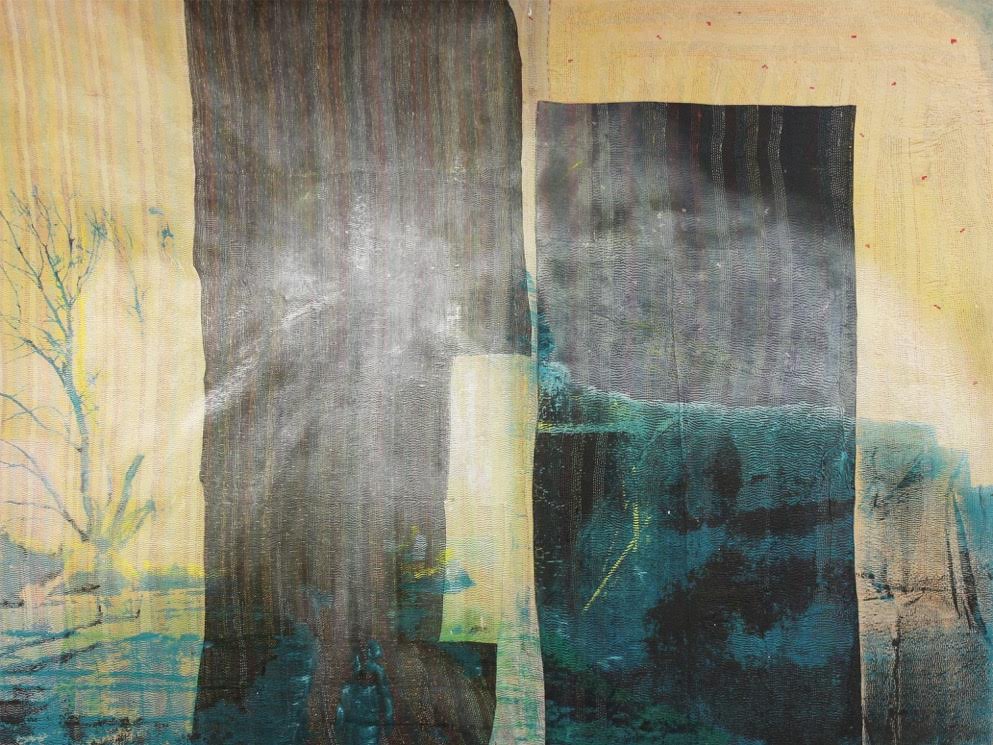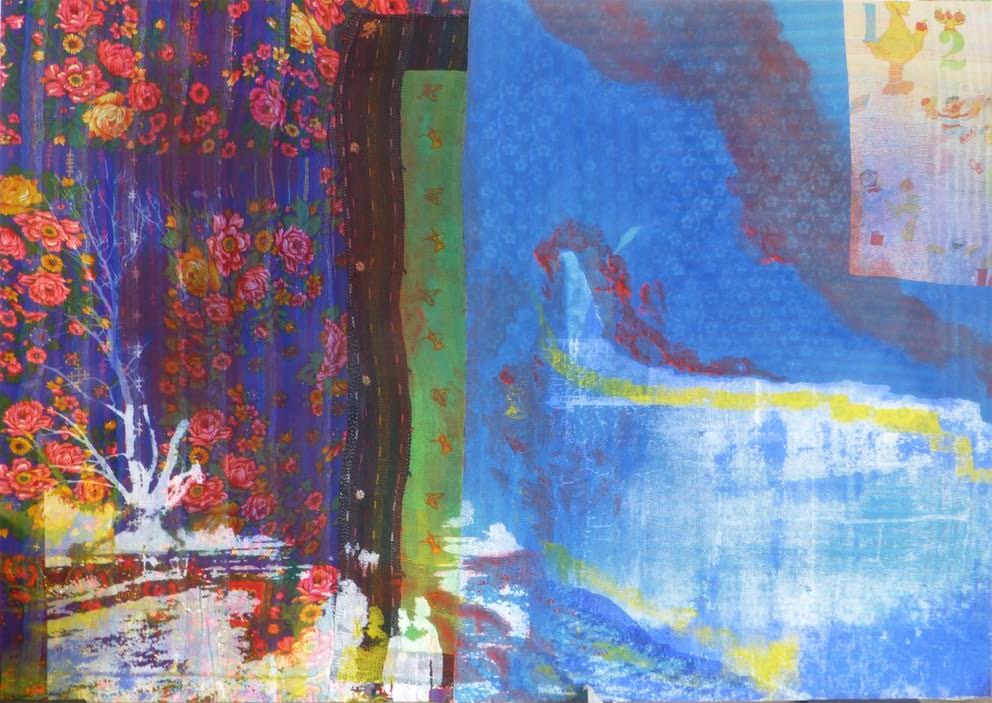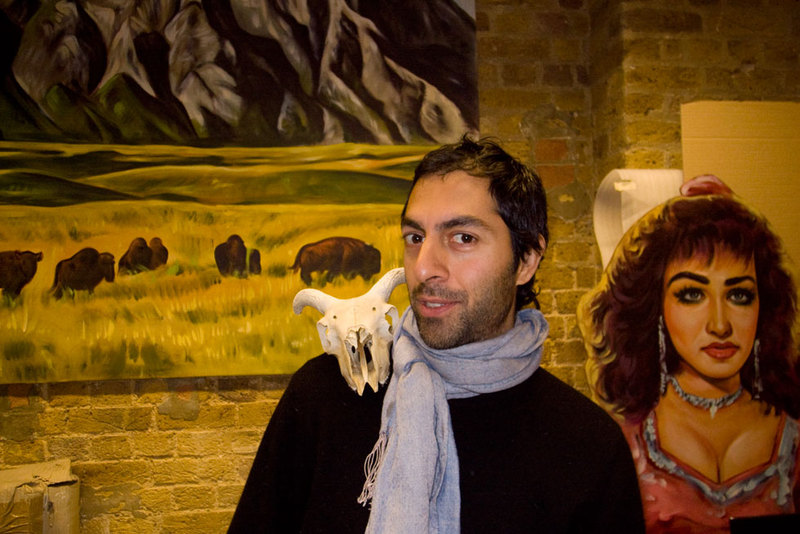I had a talk with Shezad Dawood in the gallery of Gabriel Rolt in Amsterdam, while he was installing the works for the show that opens tonight, friday October 2nd, called The double life of Arthur Schnitzler. This is a transcript of that talk. We focused on two central works in the show, both called Godstown (Autumn Evening & Winter Morning).
OvG: Shezad! My wife, Manuela Klerkx, told me that back in the day you acquired a small painting by Roman Wolgin at her gallery, in Milano, Italy. What does the work look like?
SD: It has a cartoon character on it, with a tomato like head, and a very long penis. And its looking almost in surprise at its penis.
OvG: And you are telling me that your daughter, who is three years old, is fascinated by this painting. That it is hanging in her room?
SD: I think it’s because she likes watching me pee.
OvG: She likes to watch you pee. Okay, I think we can now move on to your paintings…
SD: Haha.
OvG: I read the press release and I did my research of course, regarding Schnitzler, Freud, La Ronde, the Doppelgänger. How do I connect with all these influences? Where’s Schnitzler in the paintings?
SD: In a way, he's not. And that’s what interested me. My thinking evolves around an almost autistic set of relationships. It’s what I do at night, I make connections. At night, the world is quiet and you have time to actually go on these journeys.
OvG: Do we live in a more Freudian world at night?
SD: I think the night always has a sort of bacchanalian quality. But I don’t think a bacchanal always has to be a great orgy of dancing and feasting, it can also be an internal orgy of thinking.
OvG: Isn’t that what being an artist is all about: internal orgies?
SD: Eternal orgies?
OvG: No, internal orgies, haha. Back to Schnitzler. You say he is not present in the paintings, but he must be felt.
SD: In a way my work is almost schizophrenic. I spend a lot of time thinking and researching, and it’s equally intuitive, a wild plucking of references and coincidences.

Godstown [Winter Morning], Acrylic on Vintage textile, 190 x 265 cm, 2015
OvG: Can you tell me a little bit more about the paintings we are looking at?
SD: I’m interested in this idea of the Doppelgänger, simultaneous being truth and fiction, a fictional construct. Even Freud’s construction of Schnitzler is his own tautology. It’s a construction in his own mind, which becomes then a real fear. I’m interested in this borderline between reality and fiction. In both the work of Freud and Schnitzler it’s all about how the image functions. Whether it’s in Freud the image of the black cat or in Schnitzler, where the dream consciousness slips into the writing.
I took a photograph around Christmas time, with my wife, her sister and both her families. We were out walking, in an abandoned monastery, that’s actually is a place called Godstow.
OvG: Gods toe?
SD: No, haha, I like playing with words, but no. Godstow, t-o-w. In Oxfordshire. The light, the sun, it was winter morning, the sun was refracting just behind the monastery, in a way that made it half disappear. And it became almost like a symbolist quasi-image. I was very interested in this idea, in the reality of that moment. This painting [Winter Morning, OvG] is the first one I did, the figure is just hidden. It’s a small child, it’s actually my niece. But her presence, and that of the rest of the family, is just disappearing, into the sun. And there was this moment: the way the light was occurring, the way this ruined structure was both vanishing and appearing, it became one of those moments when time breaks down.
OvG: What do you mean by that?
SD: When past, present and future kind of occur simultaneously, but all three become less real. because they are up against eachother. And for me there was something very powerful in that, about what that said about our construct of reality. I painted it, and I actually wanted to paint it again. And I like the fact that I used the same image.
I don’t work on canvas, I work on found textiles, my work is more about cutting and montage, than about painting. My rear ground is simultaneously a foreground, a rear ground and a midground. For me, the work is inasmuch, if not more, between the works than in the works. My compulsion was to paint a second version from the same image, but changed. The artist has this power to say: this is winter evening and this is fall afternoon but it’s actually the same image. So where is the truth in that, except in a set of choices that one makes, in an encounter with reality? And that’s where Schnitzler comes in.
OvG: So, we found Schnitzler.
SD: We found Schnitzler!
If I am referring to something to literally, I cut it. For me, it has to be a relation by proxy.
OvG: You want to trigger the audience?
SD: Exactly, you hit it exactly. I am very interested in this idea of making the audience an active participant in the work, not a passive receiver: I find that patronizing and problematic.
OvG: Can we compare it to psychoanalytical therapy? The therapist is listening, not telling you what to do. He’s asking questions, not giving answers. He gives you the material, but without pointing the direction.
SD: Yes. I talked with Gabriel [Rolt, OvG] about the show, it being the third one I do with the gallery. I told him I was not interested in doing a commercial show. I was interested in a much more thoughtful, curatorial—
OvG: Philosophical?
SD: Philisophical presentation. And he said: Go for it.

Godstown [Autumn Evening], Acrylic on Vintage textile, 190 x 265 cm, ​2015​
OvG: Back to the images.
SD: There’s winter morning and autumn evening. I like this idea of a double change: it’s not just the time of year but also the time of day. But also, autumn and winter, they progress into the other. I didn’t want to to do something as dramatic as summer and winter. There’s also doublings and inversions in the textiles that I use: this particular fabric [SD refers to Winter Morning] is a South Asian reworking of an English floral motif. So, it’s a series of inversions happening here.
One of the things I love, call it a personal epiphany, is the fire of autumn. It became a metaphorical leap. I love both of these paintings, the way they confirm and deny each other. They made me think about the very strange relationship between Freud and Schnitzler.
OvG: But there was a true fear: Freud didn’t want to meet Schnitzler. Do you have an explanation for that?
SD: In the press release, which I wrote myself, I created a fictional ripost.
OvG: I liked the press release. At first I was afraid I had totally misunderstood the history between those two men, but then I looked it up on Wikipedia and noticed that you pulled some tricks, misleading the reader, on purpose.
SD: The joy of writing is to pull tricks.
OvG: What I like about it that we tend to take press releases very serious. We assume their content is ‘true’.
SD: How many press releases pull bad tricks? I like the idea that I was pulling good tricks! We all get so bored of the bad tricks, the bad sales pitches: it made me interested in turning it around, question its functioning. What was your question?
OvG: Freud and Schnitzler.
SD: A lot of my research is based on accounts of their relationship. Freud was actively avoiding Schnitzler.
OvG: Can you explain that?
SD: I have some speculative ideas, which go from ones that sound reasonable to the more unreasonable.
OvG: Let's start reasonable.
SD: Reasonable is, perhaps, that, although approaching it from different angles – one from psychoanalysis, one from fictional writing – for the theatre and novels.
OvG: And films…
SD: They were approaching the same territory.
OvG: Ego, jealousy, rivalry…
SD: Freud's writing to Schnitzler is actually true. Its my ripost from Schnitzler to Freud that is fictionalized. I think Freud was frightened of Schnitzler, in an odd way, that Schnitzler had got there, without the laborious years actually practicing with patients. He states: ‘You have reached this thing through some intuitive faculty that I do not possess’. There’s a slight inferiority complex there, and ego, around the idea of the artist. It was another funny trick I could play in terms of turning it into a press release.
I am also interested in the idea of the Doppelgänger, in terms of time travel. The idea that if you meet yourself, one of you has to cease to exist. It’s there, in Kieslowski’s great film The Double Life of Véronique. The idea: where does a paranoid construct become a real fear?
We’re always around Doppelgängers, in our presentation to others, and in our presentation to our self, more worryingly. I think it’s by acknowledging that we can come to something as the concept of being, can we come a step closer, I won’t make a bigger claim than that, a small step closer to the mystery of being.
OvG: Thanks, Shezad.
SD: My pleasure.

Shezad Dawood (1974, UK) lives and works in London. He was trained at Central St Martin’s and the Royal College of Art before undertaking a PhD at Leeds Metropolitan University. Dawood works across film, painting and sculpture to juxtapose discrete systems of image, language, site and multiple narratives, using the editing process as a method to explore meanings and forms between film and painting.
His practice often involves collaboration, working with groups and individuals across different territories to physically and conceptually map far-reaching lines of enquiry. These networks map across different geographic locations and communities and are particularly concerned with acts of translation and restaging. For example, his collaborative film project, ‘Feature’ (2008), which relocated the action of a traditional western to the English countryside, slipping into other sub-genres such as the zombie-flick, and Wagnerian opera (and features cameos from artists Jimmie Durham and David Medalla), as well as South Asian god-flick. His most recent video work, ‘Towards the Possible Film’ (2014), shot on location in Sidi Ifni, Morocco, explores anthropological concepts of indigenousness through the genre of science fiction.
Dawood’s work has been exhibited internationally, including Taipei Biennial (2014), Marrakech Biennial (2014) MACBA Barcelona (2014),​ MoMA PS1 (2014), Witte de With (2013), Modern Art Oxford (2012), Busan Biennale (2010), Tate Britain (2009), and the 53rd Venice Biennale (2009). His further extensive exhibitions include interventions in cities such as Tangiers, Mumbai, Karachi, Hamburg, and Singapore. Recent projects include feature film Piercing Brightness (2013), a solo exhibition at Parasol Unit, London, Leeds Art Gallery (2014) and at OCAT Xi’an, China (2014). Shezad is a Jarman Award nominee (2012) and one of the winners of the Abraaj Capital Art Prize (2011). He currently lives and works in London, where he is Research Fellow in Experimental Media at the University of Westminster.
PRESS RELEASE
Galerie Gabriel Rolt is proud to announce The double life of Arthur Schnitzler Shezad Dawood’s third solo show with the gallery. With a special performance on Monday 5 October at Cinetol.
In turn-of-the-last-century Vienna, Dr. Sigmund Freud went to great lengths to avoid ever meeting the celebrated Austrian playwright Arthur Schniztler, as he felt that actually meeting this, his intellectual doppelganger, might have fatal consequences.
Schnitzler in turn was to have his late novella Traumnovelle, or Dream Story adapted by Kubrick into his last film Eyes Wide Shut, starring at the time real-life husband-and-wife Tom Cruise and Nicole Kidman, as a couple torn apart by the husband’s erotic double-life.
Max Ophuls 1950 iconic film La Ronde, was also based on an earlier work by Schnitzler, the 1897 play Reigen, which consists of ten interlocking scenes between pairs of lovers, with each partner appearing in 2 consecutive scenes and therefore creating a sequence of sexual encounter played out across class lines and against the backdrop of a syphilis pandemic in Vienna.
It is hard to say who was more influential on whom, but Freud after keeping a safe distance until the age of 66, wrote the following in a letter to Schnitzler:
I have gained the impression that you have learnt through intuition – though actually as a result of sensitive introspection – everything that I have had to unearth by laborious work on other persons.
For his solo show at Galerie Gabriel Rolt, Shezad Dawood takes his conceptual starting point from an imaginary letter that he likes to think that Schnitzler might have written back to Freud:
Dear Dr. Freud,
I should like to thank you for the numerous impulses I have found in your work. The Interpretation of Dreams in particular, in its illustration of the inherent sexual pathology of the bourgeois, has afforded me much amusement.
But perhaps your desire to avoid our meeting, represents something of this pathology too, and takes too seriously the affect of the waking state? Rather fear Schadenfreude than your double revealing the fragility of the house of cards that is the human mind. As our Russian friend would have it:
‘In the doorway of the next room, almost directly behind the waiter and facing Mr. Golyadkin, in the doorway which, till that moment, our hero had taken for a looking-glass, a man was standing - he was standing, Mr. Golyadkin was standing - not the original Mr. Golyadkin, the hero of our story, but the other Mr. Golyadkin, the new Mr. Golyadkin.
The second Mr. Golyadkin was apparently in excellent spirits. He smiled to Mr. Golyadkin the first, nodded to him, winked, shuffled his feet a little, and looked as though in another minute he would vanish, would disappear into the next room, and then go out, maybe, by a back way out; and there it would be, and all pursuit would be in vain. In his hand he had the last morsel of the tenth pie, and before Mr. Golyadkin's very eyes he popped it into his mouth and smacked his lips. "He had impersonated me, the scoundrel!" thought Mr. Golyadkin, flushing hot with shame. "He is not ashamed of the publicity of it! Do they see him? I fancy no one notices him . . . "’[1]
Yours Faithfully,
Arthur Schnitzler
[1] Dostoevsky, Fyodor: The Double – A Petersburg Poem, chapter IX, (1846)
Check out the website of Gabriel Rolt gallery for more info.